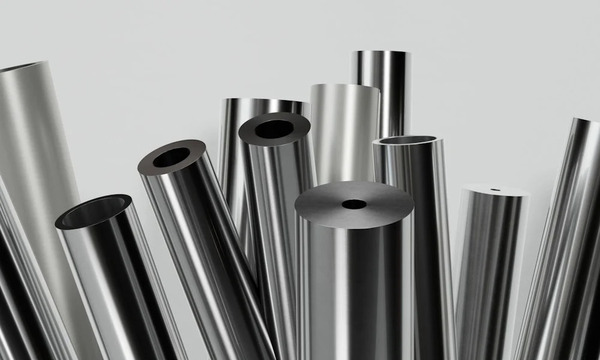Heat exchanger tubes are fundamental elements used in heat exchangers to transfer thermal energy between two or more fluids. These tubes are designed to maximize the surface area for heat exchange while maintaining efficiency and minimizing energy loss. The fluid inside the tubes absorbs or releases heat as it flows, while the other fluid, often flowing around the outside of the tubes, either heats up or cools down depending on the system’s requirements. Heat exchanger tubes are used across various industries including HVAC systems, petrochemical refineries, power generation, marine cooling systems, food processing plants, and chemical manufacturing. The selection of the right heat exchanger tube, including material, design, and dimensions, is crucial for ensuring optimal heat transfer efficiency, preventing corrosion, and minimizing fouling and blockages.
Types of Heat Exchanger Tubes
- Straight Tubes
- Description: Straight tubes are the most widely used in heat exchanger systems.
- Application: These tubes are found in most industrial heat exchangers, such as oil coolers, air-cooled heat exchangers, and some water-to-water applications.
- U-Tubes
- Description: U-tube heat exchangers feature tubes that are bent in a U shape, allowing both ends of the tube bundle to be attached at the same point, making them easier to manage in compact systems.
- Application: U-tubes are often used in high-temperature applications where thermal expansion may occur, as they allow for more flexibility without damaging the system.
- Coiled Tubes
- Description: These tubes are coiled into spiral shapes, increasing the surface area for heat exchange and making them ideal for compact installations.
- Application: Coiled tubes are often employed in applications where space is limited, such as cooling systems in small plants or laboratories.
- Double-Pipe Tubes
- Description: In a double-pipe heat exchanger, one pipe is placed inside another. The two fluids move in opposite directions, allowing for an efficient transfer of heat between them.
- Application: This type is most commonly used in small-scale heat exchangers due to its simplicity and cost-effectiveness.
- Fin-Tube Heat Exchanger Tubes
- Description: These tubes feature metal fins attached along the outside, increasing the surface area available for heat exchange.
- Application: Common in air-to-liquid heat exchangers like air conditioning units, refrigerating systems, and automotive radiators.
Materials Used for Heat Exchanger Tubes
- Copper
- Properties: Copper is known for its excellent thermal conductivity, which allows heat to transfer quickly and efficiently. It is also resistant to corrosion in non-oxidizing environments.
- Applications: Copper is commonly used in water-to-water heat exchangers, HVAC systems, and refrigeration applications.
- Stainless Steel (SS 304, SS 316, SS 316L)
- Properties: Stainless steel is highly resistant to corrosion, particularly in high-temperature and harsh chemical environments. SS 316 and SS 316L are even more corrosion-resistant and are often chosen for their durability.
- Applications: These materials are typically used in food processing, pharmaceutical industries, and marine environments, where corrosion and high temperatures are common.
- Titanium
- Properties: Titanium has excellent resistance to a wide range of aggressive chemicals and environments.
- Applications: Titanium is typically used in marine, seawater cooling systems, and applications requiring resistance to corrosion by aggressive chemicals, such as in the aerospace industry.
- Aluminum
- Properties: Aluminum is lightweight and offers decent thermal conductivity. However, it is less resistant to high temperatures and corrosive environments compared to stainless steel or titanium.
- Applications: Aluminum heat exchanger tubes are often used in automotive cooling systems, air-conditioning units, and refrigeration systems where cost-effectiveness and weight savings are important.
Applications of Heat Exchanger Tubes
- Oil and Gas
- Use: Heat exchanger tubes are used to transfer heat from one fluid to another in various oil and gas refining processes. They help maintain optimal temperatures during crude oil extraction, refining, and transportation.
- Example: Used in cooling towers, reactors, and heat exchangers for gas-to-liquid heat transfer.
- HVAC
- Use: In HVAC systems, heat exchanger tubes help cool or heat air, maintain desired temperatures in buildings, and improve energy efficiency in heating, ventilation, and air conditioning systems.
- Example: Air-to-water and water-to-air exchangers in large commercial buildings.
- Marine
- Use: Heat exchanger tubes are commonly used in marine engines, desalination plants, and heat recovery systems where they manage temperature regulation between seawater and engine fluids.
- Example: Cooling systems in ships use cupronickel or titanium tubes due to the corrosive nature of seawater.
- Pharmaceutical and Food Processing
- Use: In these industries, heat exchangers must meet strict sanitation and temperature control requirements. The tubes must be resistant to corrosion and easy to clean.
- Example: Pasteurization and sterilization processes often use high-quality stainless steel tubes to ensure clean, efficient heat transfer.
- Power Generation
- Use: Heat exchangers play a vital role in power plants by transferring heat between fluids to generate electricity. The tubes are essential in systems such as steam turbines and boilers.
- Example: In thermal power plants, heat exchangers help maintain efficiency and reduce the environmental impact by optimizing energy transfer.
Conclusion
heat exchanger tubes are at the heart of industrial cooling and heating systems, making them indispensable across a wide range of sectors. These tubes ensure the efficient transfer of thermal energy, contributing to the overall performance and sustainability of processes. Proper material selection and design considerations such as corrosion resistance, pressure handling, and heat transfer efficiency directly impact the performance and reliability of heat exchangers. Innovations in tube designs and materials continue to improve heat transfer capabilities, extend system lifecycles, and enhance the cost-effectiveness of heat exchangers in various industries.

